15th Anti-Aircraft Brigade (United Kingdom)
15th Anti-Aircraft Brigade (15th AA Bde) was an air defence formation of the Royal Artillery which saw service during the middle years of World War II. Before formation of the brigade, there were no official 'AA formations' on Gibraltar, but this shortly changed following the Battle of France. The brigade continued to serve as the prime AA defence formation until it was disbanded in 1944.
| 15th Anti-Aircraft Brigade | |
|---|---|
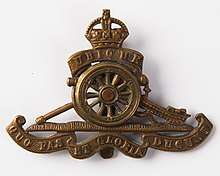 Cap badge of the Royal Artillery under King George VI | |
| Active | 1941—1944 |
| Country | |
| Branch | |
| Type | Anti-aircraft artillery |
| Role | Anti-aircraft defence of Gibraltar |
| Size | Brigade |
| Brigade Headquarters | RAF Gibraltar |
| Engagements | World War II |
| Commanders | |
| Brigadier | Duncan Learmonth |
History
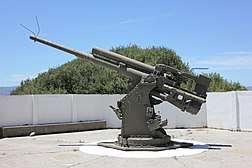
Background
On the outbreak of war in September 1939, there had only been two batteries (9 and 19 AA Btys) manning the totally inadequate AA defences of Gibraltar, which consisted of four old 3-inch guns and four new 3.7-inch guns, spread in two-gun sections to give the widest possible coverage, and two of the new Bofors 40 mm guns to protect the Royal Navy Dockyard, with the assistance of Royal Navy (RN) 2-pounder pom-pom guns. 10th AA Rgt was formed in December 1939 to command 9 and 19 AA Btys and train the AA Section of the new Gibraltar Defence Force (GDF), which took over the 3-inch guns. Apart from occasional shots fired at unidentified aircraft penetrating Gibraltar's airspace, there were no attacks on the fortress during the 'Phoney war' period.[1][2][3][4][5]
After the Fall of France in 1940, a group of AA detachments under 53rd (City of London) AA Rgt escaped from Marseilles aboard the SS Alma Dawson. A French dockyard strike prevented them from loading any of their 3-inch guns or vehicles, but they mounted Bofors guns on the ship's deck and put to sea on 18 June. On arrival in Gibraltar, they reinforced 10th AA Rgt. 82nd (Essex) AA Regiment arrived on 27 June 1940, and once it had unloaded its guns and equipment 53rd AA Rgt re-embarked for home.[2][6][7]
There followed a reorganisation of the AA units in Gibraltar: 19 AA Bty joined 82nd AA Rgt, together with the GDF HAA battery, while 9 AA Bty took over all the Bofors guns. A searchlight battery arrived, and an AA Operations Room (AAOR) was established to control all the gun sites and to coordinate with AA-equipped ships in the harbour. 10th AA Rgt HQ was ordered to be transferred to Malta in July, but this did not occur until November when, as part of Operation Coat, a reinforcement convoy for Malta put in at Gibraltar and picked it up.[2]
The first serious air raid on Gibraltar came at 02.00 on 18 July 1940, when two unidentified aircraft bombed the slopes of the Rock, causing some fatalities. The attack was thought to be by the Vichy French Air Force in retaliation for the British attack on the French fleet at Mers-el-Kebir on 3 July (Operation Catapult), which had been carried out by Force H from Gibraltar. On 21 August the AA defences brought down a Savoia-Marchetti SM.79 bomber during a raid by the Italian Regia Aeronautica. On 24 and 25 September waves of Vichy bombers attacked Gibraltar again in retaliation for the British and Free French attack on Dakar (Operation Menace), and caused considerable damage. Several of these bombers were shot down by the combined AA fire. On other occasions the guns fired at single Italian reconnaissance aircraft, known to the garrison as 'Persistent Percy'.[2][8][9][10][11][12]
Formation
During to the increase of raids and the coming North African Campaign, the War Office (WO) approved the formation of a new AA Brigade which would handle the increasing demands brought on CRA, Gibraltar. This new formation was to be known as the 15th Anti-Aircraft Brigade (15th AA Bde) which was to take over all AA matters on the rock. On 2 September 1941, the brigade was constituted with HQ based at RAF Gibraltar.[2][13][14]
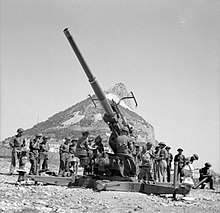
The brigade was then organised as;[14][15]
- Brigade Headquarters under Brigadier Duncan Alexander Learmonth[Notes 1][16]
- 142nd General Operation Post (Operations Room)
- 13th Heavy Anti-Aircraft Regiment, Royal Artillery (Regular, composite) — raised in Gibraltar with composite AA units based there, later disbanded on 10 December 1942
- RHQ
- 288th HAA Bty — from 94th HAA Regt, RA
- 1st Rocket AA Troop, Royal Artillery (AA Rockets)
- 1st Radar Detection Finding Bty, RA
- 82nd (Essex) Heavy Anti-Aircraft Regiment, Royal Artillery (TA)
- RHQ
- 156th, 193rd, and 256th HAA Btys
- Gibraltar Defence Force HAA Bty, RA
- 3rd Light Anti-Aircraft Regiment, Royal Artillery (Regular) — raised in Woolwich 2 September, arrived in Gibraltar on 27 September 1941
- RHQ
- 9th, 114th, and 126th LAA Btys
- 3rd Searchlight Bty, RA (Regular) — Formed 30 December 1939 in Gibraltar, formally administered by the 10th HAA Regt, RA
Gibraltar 'Blitz'
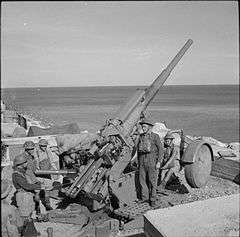
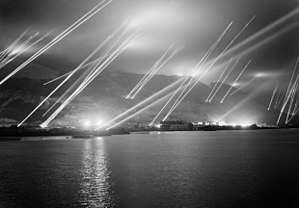
Among the many tasks facing 15th AA Brigade was the integration of AA fire in defence against sea or land invasion, in which it played an important part. Equally important was the careful distribution of gun and radar positions to ensure the most effective converge from the increased firepower and the constant practice of day and night barrages, in which live firing was regularly employed and closely recorded, to eliminate errors and weak spots. Aware of the vulnerability of positions to direct attack after opening fire, each AA position was given a 20mm Oerlikon for self-defence. The basis of the plan for the revised layer was to bring the fire of 20 HAA guns to bear on a target travelling at 240 mph, approaching from any direction and at a typical height of 12,000 feet.[2][14][17]
In January 1942, the Governor of Gibraltar, General the Viscount John Vereker, 6th Viscount Gort (Lord Gort) wrote to the War Office asking for more HAA guns, preferably 5.25 inch heavy AA guns, for GLII sets with semi-automatic plotters and another 8 x Bofors 40 mm gun (LAA guns). Part of this request was due to 15th AA Brigade's wish to provide the North airfield with its own LAA defence; hitherto it had depended on the main layout for coverage. Nothing was sent, however, other than 3-inch rockets and their launchers and the airfield received only a small deployment of 20 mm Polsten and Bofors 40 mm guns together with some machine-guns, all withdrawn from other positions, and three searchlights.[2]
During the whole of 1942, there were six bombing raids on Gibraltar, two of which were unidentified, and 18 reconnaissance overflights, all but two of them German. Four aircraft were shot down and others crash-landed in Spain. Some of the Italian raids missed their targets and dropped their bombs in Spanish territory, and Spanish AA guns sometimes opened fire as a raid passed towards them. By the end of 1942, the AA defences of Gibraltar reached a peak of scale and efficiency, but the threat had dwindled. There were only two or three reconnaissance flights during 1943.[2][18][19]
Later years
It was War Office policy that army units should be replaced after three years' service overseas. Therefore, in accordance with this policy, the 13th, 82nd, and 3rd AA regiments were removed, being replaced by the 175th and 141st. This left, the brigade organised by May 1943, as:[15]
- Brigade HQ
- 142nd General Operation Post (Operations Room)
- 175th Heavy Anti-Aircraft Regiment, Royal Artillery (Regular)
- RHQ
- 1st Range and Detection Finding (Radar) Battery
- 1st Anti-Aircraft 'Z' Troop, Royal Artillery
- 375th, 386th, 441st, and 228th[Notes 2] HAA Btys
- 141st Light Anti-Aircraft Regiment, Royal Artillery (TA)
- RHQ, 456th, 466th, and 467th LAA Btys
- 3rd Searchlight Battery, RA
By 1944, the raids from the Luftwaffe had decreased following the Invasion of France, and AA defences of the island were gradually rationalised until 19 February 1944 when brigade began to disband which was completed on 7 March.[13][14]
Notes
- Assigned directly by the Governor of Gibraltar in September 1941
- On 25 August, the battery was replaced by 596 HAA Bty, which moved 177th HAA Rgt. The former was moved to 82nd (Essex) HAA Rgt.
References
- Routledge, Table XI, p. 68; Table XIII, p. 69.
- Routledge, pp. 200-4.
- "10 HAA Rgt at RA 39–45". Archived from the original on 2011-02-18. Retrieved 2011-02-18.
- "Gibraltar Command Order of Battle (1939)" (PDF). britishmilitaryhistory.co.uk. 21 July 2019. Retrieved 4 February 2020.
- "Gibraltar, 3 September 1939". niehorster.org. 4 December 2012. Retrieved 4 February 2020.
- 53 HAA Regt War Diary 1940–41, The National Archives (TNA), Kew, file WO 166/2343.
- Joslen, pp. 552–3.
- Playfair, Vol I, pp. 130–37, 142.
- Rankin, pp. 1–7.
- Smith, pp. 57–88.
- Farndale, pp. 200–1.
- Rankin, pp. 295–9.
- Frederick, p. 1049.
- "Gibraltar Command Order of Battle (1942)" (PDF). britishmilitaryhistory.co.uk. 21 July 2019. Retrieved 4 February 2020.
- Routledge, Table XXXIV: Page 212.
- "Learmont, Duncan Alexander". generals.dk. Retrieved 4 February 2020.
- Routledge, Map 12: The Defence of Gibraltar July 1940
- "82 HAA Rgt at RA 39–45". Archived from the original on 2011-02-18. Retrieved 2011-02-18.
- Joslen, pp. 552–3.
Bibliography
- J.B.M. Frederick, Lineage Book of British Land Forces 1660-1978, Volume II, Wakefield, United Kingdom: Microform Academic Publishers, 1984 ISBN 1-85117-008-1.
- Brigadier N. W. Routledge. History of the Royal Regiment of Artillery: Anti-Aircraft Artillery 1914-55. (1994). London, United Kingdom: Brassey's Publishing. ISBN 1-85753-099-3.
- Lieutenant Colonel H. F. Joslen, Orders of Battle Second World War 1939-45, Reprinted by permission of Her Majesty's Stationery Office, Eastbourne, United Kingdom. ISBN 9781843424741.
- Martin Brayley, The British Army 1939-45 (2); Middle East & Mediterranean - Men-at-Arms Series. 2002: Osprey Publishing, Botley, Oxford, United Kingdom. ISBN 1-84176-237-7.
- Charles D. Pettibone, The Organisation and Order of Battle of Militaries in World War II, Volume II; The British Commonwealth. 2006: Trafford Publishing, Victoria, British Columbia, Canada. ISBN 141208567-5.
- Gen Sir Martin Farndale, History of the Royal Regiment of Artillery: The Years of Defeat: Europe and North Africa, 1939–1941, Woolwich: Royal Artillery Institution, 1988/London: Brasseys, 1996, ISBN 1-85753-080-2.
- Nicholas Rankin, Defending the Rock: How Gibraltar Defeated Hitler, London: Faber & Faber, 2017, ISBN 978-0-571-30770-8.